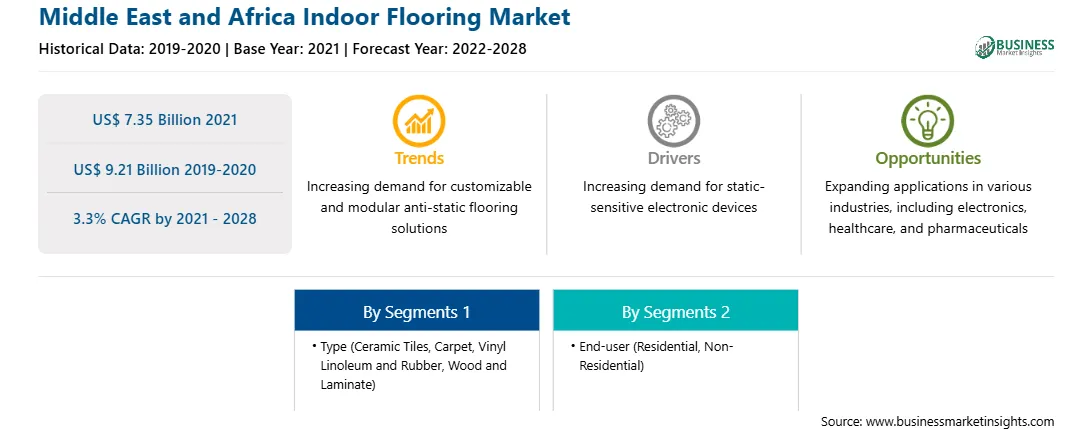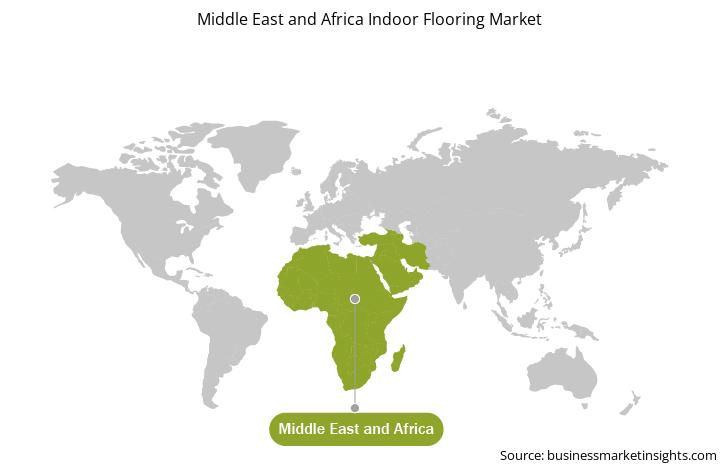中东和非洲室内地板市场预测至 2028 年 - COVID-19 影响和按类型划分的区域分析(瓷砖、地毯、乙烯基油毡和橡胶、木材和层压板等);最终用户(住宅和非住宅)。
No. of Pages: 100 | Report Code: TIPRE00027745 | Category: Manufacturing and Construction
No. of Pages: 100 | Report Code: TIPRE00027745 | Category: Manufacturing and Construction
房屋翻新和改造活动正在增加许多国家,这主要归因于政府对此的支持不断增加,特别是在发达国家。消费者愿意在生活空间的风格上花费大量资金,这吸引了消费者对地毯和地毯等家居用品的关注,以增强室内装饰的美感。这种转变受到消费者收入水平的提高、生活方式的改变以及室内装饰方面不同文化的采用的支持。将瓷砖、地毯、乙烯基、油毡和橡胶、木材和层压板等地板涂料涂在表面上,以赋予其防滑性能。除了防滑之外,它们还具有抗振、抗静电和防水性能。环氧涂料等涂料可以提高混凝土地板的耐用性。混凝土地板上的环氧树脂、聚氨酯和丙烯酸涂层使其能够承受相当大的静态和动态负载。地板涂料还可以防止这些地板表面的磨损。由于地板涂料耐清洁剂、油、氯化物、水、雪、冰、冰雹、传动液和漂白剂,因此它们越来越多地用于覆盖停车位、车库和汽车陈列室的地板。此外,它们还用于增强房屋地板的美感。室内地板材料中添加金属颜料,产生金属漩涡效果。此外,添加乙烯基色片和金属颜料以给地板表面添加丰富的色彩层和纹理的趋势日益增长。因此,上述因素可能会推动市场的增长。
中东和非洲国家中,土耳其、伊朗和南非面临最多数量的 COVID-19 病例。其他面临 COVID-19 经济影响的主要国家包括伊拉克、以色列、摩洛哥、沙特阿拉伯和阿联酋。该地区包括阿联酋和沙特阿拉伯等许多发展中经济体,由于住宅、商业和工业领域的巨大存在,这些国家是室内地板供应商的潜在市场。全球COVID-19大流行将对全球经济产生重大影响,但该地区也受到了负面影响,因为油价下跌已经给各个石油国家的经济带来了压力。除此之外,工厂停工、企业倒闭,进一步加剧了该地区国家的经济问题。抑制 Covid-19 大流行的措施,包括自我隔离、洗手和封锁,前提是社区、社会和住宅管道能够可持续地获得可接受数量的充足优质水。然而,在发展中国家,由于封锁,良好的室内装饰需求正在下降,商业地产的需求也在下降。因此,MEA 经济状况的估计下降以及 COVID-19对该地区各行业增长的影响预计将在 2021 年中期之前对该市场的增长产生负面影响。沙特阿拉伯的建筑业已从-2.8%降至-1.9%,预计2021年将反弹3.3%。这一修正反映了经济效率的提高、9月底全国宵禁的结束、以及随后放松对企业的控制。三个月的严格限制,感染发生率大幅下降。
借助新功能和技术,供应商可以吸引新客户并扩大规模他们的足迹遍布新兴市场。这一因素可能会推动中东和非洲室内地板市场的发展。中东和非洲室内地板市场预计在预测期内将以良好的复合年增长率增长。
Strategic insights for Middle East and Africa Indoor Flooring involve closely monitoring industry trends, consumer behaviours, and competitor actions to identify opportunities for growth. By leveraging data analytics, businesses can anticipate market shifts and make informed decisions that align with evolving customer needs. Understanding these dynamics helps companies adjust their strategies proactively, enhance customer engagement, and strengthen their competitive edge. Building strong relationships with stakeholders and staying agile in response to changes ensures long-term success in any market.

| Report Attribute | Details |
|---|---|
| Market size in 2021 | US$ 7.35 Billion |
| Market Size by 2028 | US$ 9.21 Billion |
| Global CAGR (2021 - 2028) | 3.3% |
| Historical Data | 2019-2020 |
| Forecast period | 2022-2028 |
| Segments Covered |
By 类型
|
| Regions and Countries Covered | 中东和非洲
|
| Market leaders and key company profiles |
The regional scope of Middle East and Africa Indoor Flooring refers to the geographical area in which a business operates and competes. Understanding regional nuances, such as local consumer preferences, economic conditions, and regulatory environments, is crucial for tailoring strategies to specific markets. Businesses can expand their reach by identifying underserved regions or adapting their offerings to meet regional demands. A clear regional focus allows for more effective resource allocation, targeted marketing, and better positioning against local competitors, ultimately driving growth in those specific areas.

The Middle East and Africa Indoor Flooring Market is valued at US$ 7.35 Billion in 2021, it is projected to reach US$ 9.21 Billion by 2028.
As per our report Middle East and Africa Indoor Flooring Market, the market size is valued at US$ 7.35 Billion in 2021, projecting it to reach US$ 9.21 Billion by 2028. This translates to a CAGR of approximately 3.3% during the forecast period.
The Middle East and Africa Indoor Flooring Market report typically cover these key segments-
The historic period, base year, and forecast period can vary slightly depending on the specific market research report. However, for the Middle East and Africa Indoor Flooring Market report:
The Middle East and Africa Indoor Flooring Market is populated by several key players, each contributing to its growth and innovation. Some of the major players include:
The Middle East and Africa Indoor Flooring Market report is valuable for diverse stakeholders, including:
Essentially, anyone involved in or considering involvement in the Middle East and Africa Indoor Flooring Market value chain can benefit from the information contained in a comprehensive market report.